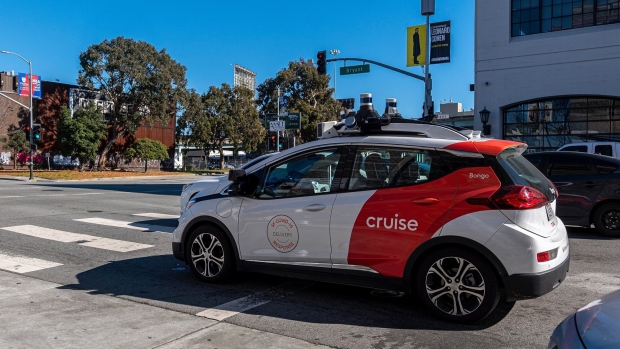Dec 14, 2023
GM’s Cruise Dismisses 900 Employees, Cutting 24% of Workforce
, Bloomberg News

(Bloomberg) -- Cruise LLC is cutting 24% of its workforce, extending an overhaul of the troubled autonomous-vehicle business after it dismissed nine top executives.
The layoffs, which amount to about 900 positions, will primarily affect workers in operations roles, according to a memo to employees Thursday from President Mo Elshenawy. Some technology positions will also be affected, but engineers will largely be spared from the cuts.
The company, which is majority owned by General Motors Co., has been reevaluating its once-aggressive growth plans after an Oct. 2 incident in which one of its vehicles struck and dragged a pedestrian for 20 feet. The resulting regulatory scrutiny led Cruise to fire executives who managed the company’s response and to pull back operations.
With the job cuts, GM is also reducing its spending on Cruise, which totaled $700 million in its most recent quarter. The restructuring moves give the robotaxi unit time to examine the safety of its self-driving technology and rebuild the business at a more conservative pace than it had under former Chief Executive Officer Kyle Vogt, who resigned last month.
“While we remain committed to commercialization, we will approach it within a thoughtful and achievable time frame — with safety as our north star,” Cruise said in a statement Thursday. The decision to cut jobs “reflects our new future and a more deliberate go-to-market path, meaning less immediate need for field, commercial operations and corporate staffing.”
GM’s shares rose 5.5% as of 1:41 p.m. in New York.
Cruise’s new strategy scraps Vogt’s push to expand to more than 12 cities by the end of 2024. Under the former CEO and founder, the company was pressing ahead with expansion even as its had to recall cars to make software changes and had other traffic problems, such as holding up other drivers by stopping in intersections and running into a fire truck.
Under Vogt, Cruise had a target of bringing in $1 billion in revenue in 2025 and $50 billion by 2030, which made it a big piece of GM CEO Mary Barra’s goal of doubling revenue to $280 billion by the end of the decade.
Read More: Mary Barra’s $280 Billion Goal Is Proving a Stretch for GM
In the letter to staff, Elshenawy said the cuts target operations because the company won’t grow the robotaxi business until it is certain the vehicles are safe.
He also said Cruise maintains its goal to develop a fully driverless service that meets a new performance bar, but which prioritizes the existing electric Chevrolet Bolt AV model instead of a new dedicated-purpose autonomous vehicle. Cruise wants to relaunch the robotaxi business in one city to start and build its safety standards before pushing for scale. GM has stopped work on a six-passenger autonomous shuttle for model year 2024 called the Cruise Origin.
Growing Problems
Cruise’s problems multiplied in late summer after the company got permission to charge fares and drive 24 hours a day in San Francisco. A week later, one of its cars failed to yield to the firetruck. The next day, on Aug. 18 the California Department of Motor Vehicles ordered the company to cut its fleet in half.
A major blow came in early October, when a Cruise vehicle hit a pedestrian after she was struck by another car, and then dragged her along the street about 20 feet, causing serious injuries.
Cruise subsequently described the incident in an email exchange with regulators that referred to the “impact with the pedestrian” but didn’t mention the dragging. In the message, David Estrada, a Cruise government affairs executive who was dismissed on Dec. 13, said the events were captured on video.
Later that month, California regulators suspended Cruise’s license to operate as authorities accused the company of hiding details of the incident. Cruise has denied that it wasn’t forthcoming.
(Updates with additional details beginning in second paragraph)
©2023 Bloomberg L.P.


